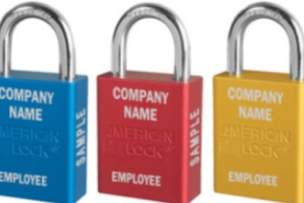What OSHA Requires in Group Lockout/Tagout
OSHA requires that group lockout/tagout procedures provide the same level of protection as provided by a personal lockout or tagout device. These are described in OSHA Standard CFR 1910.147, which regulates the control of hazardous energy.
OSHA also mandates that:
- An authorized employee be made primarily responsible for a group lockout or tagout device covering multiple employees.
- It is the responsibility of that primary authorized employee to ascertain the exposure status of individual group members and to coordinate affected work forces if multiple crews or departments are involved.
- The primary authorized employee places a personal lockout or tagout device to a group lockout device on the affected machinery before work begins, and removes the personal device when work is complete.
In addition, OSHA requires facilities to have procedures in place to ensure continuity of the LOTO process through shift and personnel changes.
Using Lockout Hasps and Lockboxes
In its compliance document, OSHA describes several acceptable group LOTO procedures. These include the use of hasps or the use of a lockbox.
“The hasp method for group lockout requires each employee to place his or her personal lock to each energy disconnect,” says Dana Andersen, writing for ESC Services. “The authorized employee that is assuming the responsibility will place their lock on the hasp first at every energy disconnect, and every other employee performing the maintenance must place their lock on each hasp as well.”
Andersen notes that hasps work best with smaller groups of employees. Grover recommends that hasps be required at every energy isolation point, even when a lone employee is locking out, in case additional help is needed during a task.
“This will allow, whenever necessary, a short-term authorized helper to add his lock immediately into the safety system, test the controls for zero movement and go to work to assist with the task,” he says. “When the authorized helper’s work is complete, he can remove his lock from the hasp(s) without the original worker’s safety being compromised or distracting their focus on the task being completed.”
For larger groups, or groups where members may join or leave, a lockout box is more efficient. There are a variety of ways to use the boxes, which OSHA describes in the compliance document. But in general, the box allows the primary authorized employee to maintain control over multiple locks.
“The group lockbox method only requires one employee to affix multiple locks to the machine, while everyone else applies just one lock to the lockbox,” Andersen explains. “The authorized employee that has been designated to assume the responsibilities of the group will be required to place personal locks on each energy disconnect, place the keys to those locks inside a lockbox, and lock the lockbox with an additional personal lock. Next, the other employees performing the service will inspect the lockout and afterward place his/her own personal lock on the lockbox as well.”
Need help choosing the right lockout/tagout kit for your needs? Working with hydraulic or pneumatic systems? Use our interactive lockout/tagout product selector guide.
Checklist: Group Lockout/Tagout Procedure
In the white paper “Machine Safeguarding, LOTO, and Electrical Safety: Integral and Interrelated,” Travis Rhoden of J. J. Keller & Associates says some basic steps apply to every lockout procedure.
Download this checklist.
- Prepare for shutdown (review the procedure and identify the machine’s energy sources)
- Shutdown
- Notify affected employees
- Isolate equipment
- Apply LOTO devices
- Release stored energy
- Verify that the machine is isolated
Here is a checklist of tasks for various workers during a more complicated lockout or tagout—one involving multiple employees, multiple shifts or multiple energy sources.
Lead Authorized Worker
- Review the energy isolation plan.
- Get permission to remove equipment from service.
- Notify affected workers before removing equipment from service.
- Shut down equipment.
- Apply a color-coded personal lock and color-coded master lock to the group lockbox on the equipment. The master lock is the first to be applied and the last to be removed.
- In the case of shift or personnel changes, ensure the orderly transfer from off-going employees to on-coming employees.
- When informed that service or repair is complete, the primary authorized worker verifies all authorized workers are signed off and all locks and tags have been removed.
- After locks have been removed, check the area and machine to make sure energy can be safely restored and that machine controls are in an off position before removing personal lock.
- Notify affected workers before restoring equipment to service.
Qualified Electrical Worker
- Assist lead authorized worker in isolating energy sources.
- Perform and sign off on zero voltage verification.
Authorized Worker
- Assist lead authorized worker in isolating energy sources.
- Each employee performing servicing or maintenance activities affected by the EIP must affix their own device to the group LOTO device.
- Authorized workers coming on-shift to work on equipment that has already been locked out should reaffirm that the equipment has been de-energized.
- Complete service or repair.
- When service or repair is complete, inform the primary authorized worker of their intent to lock off and remove their locks from the group lockbox or device.
Outside Personnel
- Discuss energy isolation plans with on-site employer.
- Either plan can be used as long as it meets the OSHA standard, but each employer has a responsibility to protect its employees from hazardous energy.
- All employees, contract or on-site, must abide by the rules of the energy isolation plan in use.
Are you confused by OSHA’s designations for different worker types? Read “Lockout/Tagout Procedure Tips: Authorized Vs. Affected Employees.”
CLICK HERE to explore product solutions that help maintain a safer workplace while working with electricity.





Talk to Us!
Are tags required on the lock box for the employees that are part of the LO/TO process
21Leave a reply
Your email address will not be published. Required fields are marked *